





This issue of Conserve celebrates our 90-year anniversary. Community leaders in the early 1930s had profound foresight to create this organization and to realize what it could do for Pittsburgh and Western Pennsylvania. For 90 years the Conservancy has protected and enhanced the most spectacular resources in our wonderful region. Since its beginning, the work of the Conservancy has been a collective effort. We have worked with our members, donors, staff, board, partners and volunteers all of us together have led to the impacts the Conservancy has had on our region.
The beauty and ecological importance of our region have deserved this effort. It's a region of extensive forests, scenic mountain ridges, broad rivers, wild streams, scenic vistas and miles of farmland. Our region has biologically diverse ecosystems, and habitats important to its wide range of plant and animal species. And our region has a UNESCO World Heritage Site, with the recent designation of Frank Lloyd Wright’s Fallingwater. It’s an unusual region beautiful, dramatic, varied and scenic.
Since 1932, we’ve helped establish 11 state parks and protected more than a quarter million acres of open space. We have planted many thousands of trees. We have planted gardens in our cities and towns, and restored rivers and streams throughout the region. We’ve studied wildlife habitats and worked to protect our threatened and endangered species. We maintain 41 preserves for people to enjoy. And we’re the stewards of Fallingwater the most significant addition to the Conservancy’s holdings over its 90 years, and a pleasure to preserve and to share with the public.
The longevity of the organization means that we can keep working in an area until the cumulative impacts make a meaningful difference. Whether it’s land protection along the Clarion River, in the Laurel Highlands or within the French Creek watershed, the Conservancy ends up with protected acreage at a scale that has true impact. Along our city streets and rural streams, we have been able to plant 105,000 trees because of the ongoing nature of the work. And progress at Fallingwater builds on itself, whether it’s preservation work that advances with time, or education and history telling that becomes richer over time.
We are humbled by the generosity of so many people who have allowed the Conservancy to accomplish what it does. You allow us to continue to advance our mission. And your continued support will be vital to addressing tomorrow’s conservation and preservation challenges. We are committed to thinking strategically to ensure that our natural resources are protected and thriving, and working to leave future generations a better Western Pennsylvania.
We hope you will enjoy this issue of Conserve, which features a timeline that portrays the tangible impact of the work you have helped to make possible. The Western Pennsylvania Conservancy’s board and staff want to thank you for your extraordinary support and generosity that allow our work to continue and build, 90 years later, and to move ahead into the future.

Thomas D. Saunders PRESIDENT AND CEO
We’re indebted to our members, volunteers and partners for your passion and enthusiasm to protect and restore nature in Western Pennsylvania. We have a remarkable, powerful and shared legacy of making our corner of the world a better place to live, work and explore for all of us and future generations. For nine decades, we’ve worked side-by-side in many communities, towns and cities around the region to achieve milestones and make sure the exceptional natural places in our region are thriving. Thank you.

1932: During the Great Depression, 10 citizens form the Western Pennsylvania Conservancy under its former name — Greater Pittsburgh Parks Association — on February 16, 1932, to alleviate widespread unemployment through public works programs, and to create a positive impact on the region’s natural resources.

The Western Pennsylvania Conservancy protects and restores exceptional places to provide our region with clean waters and healthy forests, wildlife and natural areas for the benefit of present and future generations. To date, the Conservancy has permanently protected more than 264,000 acres of natural lands. The Conservancy also creates green spaces and gardens, contributing to the vitality of our cities and towns, and preserves Fallingwater, a symbol of people living in harmony with nature.
OFFICERS
Carolyn Rizza Chair
Debra H. Dermody Vice Chair
Daniel S. Nydick Treasurer
Bala Kumar Secretary
BOARD OF DIRECTORS
David Barensfeld
Franklin Blackstone, Jr.*
Barbara Bott
E. Michael Boyle
Geoffrey P. Dunn
Beverlynn Elliott
Donna J. Fisher
Susan Fitzsimmons
Paula Foradora
Dan B. Frankel
Dennis Fredericks
Felix G. Fukui
Caryle R. Glosser
Carolyn Hendricks
Candace Hillyard
Robert T. McDowell
Paul J. Mooney
Stephen G. Robinson
Thomas D. Saunders
Samuel H. Smith
Alexander C. Speyer III
K. William Stout
Megan Turnbull
Joshua C. Whetzel III
Gina Winstead
*Emeritus Director
“It is a wholesome and necessary thing for us to turn again to the earth and in the contemplation of her beauties to know the sense of wonder and humility.”
– Rachel Carson, American biologist, environmentalist, author of “Silent Spring” and Conservancy member from 1959 to 1964
1940: The Conservancy’s first project is greening a blighted city hillside.
The roots of the Western Pennsylvania Conservancy take hold! For our first big restoration project, we plant trees, vines and shrubbery and secure and maintain a blighted hillside on Pittsburgh’s Bigelow Boulevard. During the next 90 years we grow strong and branch out, making our communities in Western Pennsylvania healthier, greener places to live, work and play.
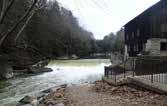
We protect land for McConnells Mill State Park.
The stage is set for outdoor enthusiasts to enjoy 1,000 scenic acres in the Slippery Rock Creek gorge and the historic gristmill when we protect them for McConnells Mill State Park. The Pennsylvania Power Company had invested more than $100,000 in the site, but in the name of protecting nature, the company’s president, Lou Round, convinces shareholders to sell the land to the Conservancy for $30,000. It’s the first of 11 state parks we help establish in coming decades. Thousands of people each year experience the sandstone boulders and tall hemlocks along the trails above Slippery Rock Creek, and other recreational opportunities at the park.
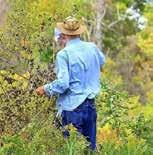
“As a landscape painter, I am deeply grateful for the work of the Western Pennsylvania Conservancy. In the field, I am mindful of the words of Frank Lloyd Wright, whose work is venerated by the Conservancy: Study nature, love nature, stay close to nature. It will never fail you.'”
– Geoff Dunn, WPC member and board member

McConnells Mill and its 1,000 surrounding acres, now under the Conservancy’s protection, need care and attention. Moses Wharton is hired as our first employee. Born into slavery in North Carolina in 1860, Moses made his way north in his late teens and found work as a handyman at the gristmill that later became the centerpiece of the park. During a time when men of color were not recognized for their work and knowledge of our natural landscape, he dedicates many years of his life as a local historian and conservationist before passing away in 1954 at age 94.

1961-68:
Thanks to our work to conserve 10,000 acres along the Youghiogheny River in Fayette County, we now enjoy the whitewater, hemlocks, natural beauty and trails at Ohiopyle State Park. At 20,500 acres it’s the largest state park in Pennsylvania!

The Kaufmann family always knew Fallingwater would be more than a summer home for their use … they knew this stunning architectural masterpiece should be shared with the world. "Such a place cannot be possessed," Edgar jr. said at the dedication ceremony in 1963. "Over the years since it was built, Fallingwater has grown ever more famous and admired, a textbook example of modern architecture at its best. By its very intensity it is a public resource, not a private indulgence." Fallingwater opens to the public in July 1964. Admittance is by advance reservation through the Conservancy office in Pittsburgh. Word spreads fast ... 29,792 people visit the house that year.
1951: We acquire Ferncliff Peninsula through a gift from Edgar J. Kaufmann Charitable Trust. This land establishes Ohiopyle State Park in the 1960s. As of 2022, we've protected approximately 83,000 acres in the Laurel Highlands.
1964: Fallingwater welcomes its first artist-in-residence, Roger Tory Peterson, a naturalist, ornithologist and illustrator. While there, he illustrates his book “Field Guide to Mexican Birds.“
1968: Kaufmann dairy barn converts to Bear Run Nature Education Center with an extensive nature education program conducted by Dr. John Hug, who lived on one of the houses on the property. Hug ran the nature center five days per week and also expanded the Conservancy’s nature education program with advice to schools and curriculum preparation.
“I have always enjoyed the outdoors; however, working as a volunteer has opened my eyes to so many plants and species around us.”
–Terry Christopher, volunteer
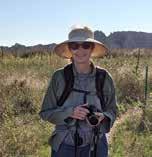
1952: Land is saved for wildflowers, birds and bees with our land protection to establish Jennings Nature Reserve in Butler County. Additional land is acquired in 1962 and 1969 to total 310 acres.
1959-64: We conserve 3,000 acres along Muddy Creek in Butler County, which today serves as the nucleus for Moraine State Park.
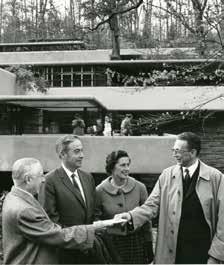
1961-63: Visitors to Raccoon Creek State Park in Beaver County appreciate the serenity and beauty of the 300-acre wildflower reserve, thanks to land we conserve to establish it and the park.
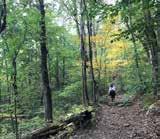
1966-68: We conserve 11,230 acres along Laurel Ridge, from the Youghiogheny River to the Conemaugh River and give this land to the Commonwealth to establish Laurel Ridge State Park and the 70-mile Laurel Highlands Hiking Trail.
Edgar Kaufmann jr. entrusts Frank Lloyd Wright’s masterpiece, Fallingwater, to the Conservancy, with its buildings, art collections and setting intact. The gift includes the wild and beautiful Bear Run and 469 acres surrounding the house, and a $500,000 endowment to care for the house. An area of great natural diversity, Bear Run Nature Reserve features outcroppings of Pottsville sandstone and supports native trout, numerous birds, black bears, bobcats and other wildlife. “In Fallingwater, Wright captured the perfect essence of our desire to live with nature: to dwell in a forested place and be at home in the natural world,” says Edgar jr.
Read more about “The Kaufmann Conservation on Bear Run, a Memorial to Edgar J. and Liliane S. Kaufmann.”
1966-69: We transfer 897 acres In Venango County to the Commonwealth for the creation of Oil Creek State Park.

“I have always had a huge interest in forestry, trees and being outside.” Melissa says she’s learned a great deal about conservation and working in an organization from her transition from an intern to staff. “I’m learning a lot at and about the Conservancy. I feel comfortable expressing my perspectives, being authentic at work and exploring opportunities in leadership on my team and in the community.”
– Melissa Burnett, former PULSE Fellow and now a member of our community gardens and greenspace field staff
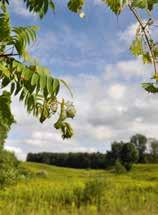
1969: Wattsburg
Fen Natural Area establishes our French Creek watershed work.
We protect 292 acres in Erie County to establish Wattsburg Fen Natural Area, our first major project in the French Creek Watershed. This natural area hosts rare wetland habitats and plants, such as highbushcranberry, alder-leaved buckthorn, leafy northern green orchid, slender cotton-grass and mud sedge. Calcareous fens are rare in Pennsylvania, and those of glacial origin are only found in the northwestern part of the state. Hikers, birders and hunters can enjoy the property. Due to the variety and abundance of aquatic wildlife and rare plant and animal species, French Creek is the most biodiverse stream of its size in the Northeastern United States. The 1,250-square-mile French Creek watershed is a priority conservation region where we have conserved more than 6,000 acres as of 2022.
“Preservation of high-value sites, maintenance of reasonable public access and the comradeship of working with like-minded people keeps me energized and involved.”
– Alan Hunninen, WPC member and volunteer

1970-81: More than 9,100 acres of forested shoreline and islands in the Allegheny River corridor from Warren County to Allegheny County is acquired. We transfer and add most of this land to the beautiful and majestic Allegheny National Forest.
Our community vegetable and flower gardens begin to bloom.

How about those groovy outfits and hairdos?
In 1978, our community vegetable and flower gardens in Pittsburgh begin to bloom, starting with a flower garden on Hamilton Avenue in Homewood. Today, we're still helping Pittsburghers grow healthy, fresh produce for communities by partnering with Grow Pittsburgh to provide technical and financial support to existing community vegetable gardens. And, our flower gardens provide beauty and color in 130 communities across the region as well as habitat for insects, birds and small animals and food for pollinators.

1979: We conserve 12,670 acres of wild mountain land in Clinton and Centre counties for the creation of State Game Land #295. The largest project in Conservancy history to this date, this tract is best known for its famed wilderness trout stream — Cherry Run. This conservation also protects four other mountain streams and nearly 20 square miles of game-rich forestland.
1983: We save additional habitat for Pennsylvania's restored elk herd with the purchase of 176 acres, which adds to Elk State Forest in Elk and Cameron counties.

1983: Our membership swells to nearly 11,000 nature lovers from all 50 states.
1986: Fallingwater establishes the Friends of Fallingwater giving society.
1986: Fallingwater celebrates its 50th anniversary.
1986: Edgar Kaufmann jr. publishes "Fallingwater: A Frank Lloyd Wright Country House."
Designed by Paul Mayén, partner of Edgar Kaufmann jr., Fallingwater's Visitor Center is built in 1979 but is destroyed by fire one day after opening. It is immediately rebuilt and reopened in 1981. Now housing the Fallingwater Café, the Fallingwater Museum Store and the Speyer Gallery, it combines conservation, simplicity and hospitality in an elegant design that does not compete with the house. The American Institute of Architects Journal editor and critic Stanley Abercrombie praises the design’s independence, saying, “The new construction coexists happily with [Fallingwater] by having, on the surface, nothing to do with it,” but that Wright’s house cantilevered over Bear Run and Mayén’s “spirited and fresh little building” share an attitude of loving care for their natural surroundings.
Read about the Visitor Center.
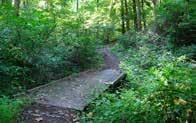
1976-79: We establish Beechwood Farms Nature Reserve in Fox Chapel, Allegheny County through a donation of 90 acres from Mrs. John F. Walton, Jr., and Mr. and Mrs. Joshua C. Whetzel, Jr.
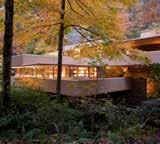
1976: Fallingwater is designated a National Historic Landmark by the United States.
Fallingwater is designated a National Historic Landmark by the United States Department of the Interior on May 11, indicating that the site possesses national significance in commemorating the history of the United States of America.
1979: Our 100-acre Wolf Creek Narrows Natural Area in Butler County is eatablished. The site is famous for its spectacular display of spring wildflowers.
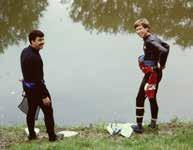
The Pennsylvania Natural Heritage Program (PNHP) is founded.

“ To work with people from all over the world, in our little corner of the world –that is very rewarding. I feel honored to work at a history-laden landmark surrounded by natural beauty. Wherever I am on site on any given day is what I love.”
– Lynn Miles, senior visitor
representative at Fallingwater
“The mission of WPC and Fallingwater is so important to protect and preserve our natural and architectural wonders.”

WPC establishes the GAP Trail.
Bicyclists can pedal along the wild and beautiful Youghiogheny River when we establish the Great Allegheny Passage Trail in 1978. We acquire 27 miles of railroad corridor from Connellsville, Pa., to Confluence, Pa., creating the first leg of the GAP Trail. And in 2019 we finish the Joshua C. Whetzel Memorial Recreation Area, with a view overlooking the town of Confluence, Pa., the Youghiogheny River and the GAP. We have protected about 700 acres along the GAP between Confluence and the Pennsylvania-Maryland state line and much more acreage in Ohiopyle State Park and points west.
If you enjoy hiking near lush vernal pools, appreciate clean rivers that are filtered by freshwater mussels and understand that the eastern massasauga rattlesnake has an important place in our ecosystem, thank our Pennsylvania Natural Heritage Program team! In 1982, PNHP is founded. Our experts inventory and monitor rare species and natural communities; hundreds of projects provide scientific information and data helps to track changes among these species and communities and to conserve and steward biological diversity. In 2006, the multi-organization heritage program becomes a statewide partnership between the PA Department of Conservation and Natural Resources, the PA Fish and Boat Commission, the Pennsylvania Game Commission and the Conservancy, in cooperation with the U.S. Fish and Wildlife Service.

1983: Green salamander is seen in PA for the first time in 20 years.
Since 1951 the Pennsylvania green salamander, rare in the state, had only been documented from its single original collection site. Armed with topographic and geologic paper maps and a compass, Pennsylvania Natural Heritage Program staff member Charles Bier begins methodically searching suspected habitats across mountainous portions of Pennsylvania’s southwestern corner. Although Charles finds the green salamander at additional locations, his work supports the original thought that it lived in rare habitats. The Fish and Boat Commission lists it as state threatened. As of 2022, it is still confined to the Chestnut Ridge south of the Youghiogheny River in Fayette County. Although the green salamander was discovered in Pennsylvania more than 70 years ago, PNHP staff continue to fill in data gaps. This rare species faces challenges such as altered or destructed habitat, climate change, disease and genetic isolation.

1987: Within the Allegheny National Forest, we acquire the gas ownership under the Tionesta Research Natural Area and adjoining Tionesta Scenic Natural Area, which are home to trees more than 400 years old. This work enables their full protection.
1989: Our downtown Pittsburgh beautification begins when we establish flower gardens at Point State Park.
1992: PNHP documents the newly federally listed northeastern bulrush.
“There is nothing more powerful than the push to break barriers. By partnering with us, WPC is saying ‘We’re working with Landforce because of who they serve.’”
– Jasimine Cooper, director of workforce development at Landforce Landforce helps Pittsburgh organizations restore and maintain land and green assets while providing people from underserved communities or who have employment hindrances opportunities to learn skills in the environmental field.
1993: Land known for its wilderness and high-quality trout streams becomes protected with the acquisition of the 11,300-acre President Oil property between Tionesta and Oil City.
1998: Forty Pittsburgh public schools come alive with flowers in the second year of the School Garden Initiative. The program began in 1997.
1989: PNHP initiates natural heritage inventories of PA’s 67 counties to record critical rare, endangered or threatened species and other biodiversity features.

1991: Access to French Creek enhances, with the addition of streamside land located north of the Utica Bridge between the creek and the railroad tracks.
The PA Fish and Game Commission now owns this access. Since the late 1960s, we strategically work with many friends, partners and landowners in the French Creek watershed.
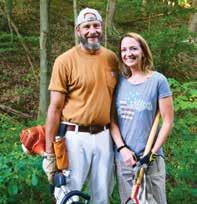
1992: WPC conveys the last nine miles of right-of-way for the Youghiogheny River Bike Trail to the commonwealth, which will extend the bike trail from Bruner Run to Connellsville, Pa.
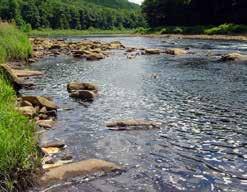
1995: We acquire nine tracts totaling 1,341 acres in the Clarion River watershed as we continue work on the Clarion River Project, established to help safeguard land and water for the Clarion River, part of the National Wild and Scenic River System. As of 2022, we've protected nearly 13,000 acres along the river.
“When a child says that they will look for birds the next time they are outside, or a high school student becomes aware of conservation issues facing their community, that’s when you know our education work is making a difference.”
– Danielle Forchette, WPC education coordinator
1998: WPC celebrates the designation of the Sideling Hill Creek Watershed as “Exceptional Value” watershed by the PA Department of Environmental Protection.
1998: One hundred WPC volunteers, with Duquesne Light and The Pittsburgh Project, complete nine hours of planting The Welcome Garden, using more than 30,000 flowers, at the entrance to the Fort Pitt Tunnels.
1992: WPC protects 67 acres containing Sideling Hill Creek barrens, the largest shale barren along the Pennsylvania portion of the stream. In 2022, the 375-acre Sideling Hill Creek Conservation Area in Bedford and Fulton counties protects some of the rarest habitat in Western Pennsylvania.

“We live in Ohio Township and really appreciate that this beautiful urban forest is right in our backyard. There’s no other place like it close by.”
– Joy Ruff and husband, Derek, are two of many volunteers who helped restore Toms Run Nature Reserve
Working in conjunction with state and environmental partners, we complete “A Study of Calcareous Fen Communities in Pennsylvania,” which develops comprehensive descriptions of calcareous wetlands across the state. Calcareous wetlands have waters with pHs above seven, are generally found along and north of the glacial moraines in the northeast and northwestern regions of the state, and are considered among the rarest habitats in the state. Fens, a type of wetland, develop under the influence of neutral or alkaline waters.
The study provides baseline data so we better understand fen communities and the range of variation within and among the plant communities. Our work provides data for their natural heritage classification. This is the first of many fen studies the Pennsylvania Natural Heritage Program conducts.

1997: Upon Fallingwater’s construction in 1938, the concrete terraces that appear to float above the waterfall are hailed as a daring architectural achievement. But Wright’s design contains a critical flaw. It does not include enough support, and the terraces begin to sag. Cracks eventually form. Concern grows that the terraces could collapse. Fallingwater’s exterior is braced with shoring to prevent further deflections until a design solution can be developed to repair the cantilevers.
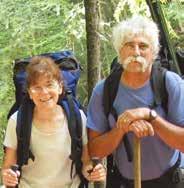
“You can walk the same path that you’ve walked dozens of times and still discover something new. I discovered a fragrant spicebush during a walk with my daughter recently and now I’m noticing it everywhere! Nature is never boring.”
– WPC member Kathy Kunz, seen here enjoying nature with husband, Denny

1999: “Pittsburgh: The City That Blooms!,” a project of WPC and the Pittsburgh Downtown Partnership, launches with 246 hanging baskets suspended along several busy downtown Pittsburgh streets, with funding by the Grable Foundation to establish the program. Since 2005, the Laurel Foundation has generously funded 400 baskets annually.
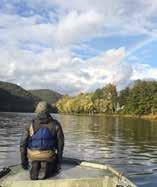
In 2001, our Watershed Conservation program begins as the Watershed Assistance Center. It is created to carry out our commitment to partner with and provide technical assistance to local landowners, watershed groups and the community on water quality-related issues. During the next 21 years, volunteers and partners help protect or restore more than 3,000 miles of rivers and streams, and plant more than 66,000 riparian trees to improve degraded aquatic and riparian habitats, including on farms and other privately owned land.
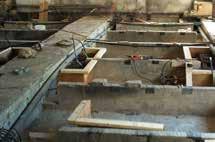
In 2001, the post-tensioning of Fallingwater’s living room cantilevers begins. A restoration team led by Robert Silman Associates installs post-tensioned high-strength steel cables beneath the floors and alongside three of the four beams of Fallingwater’s main cantilever, as well as several east-west joists. The process works much like a suspension bridge in which the cables are anchored at the ends of the expanse and rise in the middle, structurally supporting the bridge deck.



1999: Nature lovers volunteer to help care for WPC’s thousands of acres of land and nature preserves as part of our land stewardship program. As of 2022, we care for and provide 41 preserves for all to enjoy.
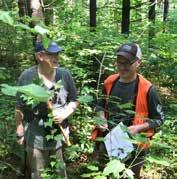
“As I walk Toms Run Nature Reserve and see those large maples and oaks, and hear the babble of the running streams, I instantly know my time, care and hard work are making a real difference, one tree and stream at a time.”
“I often enjoy the peaceful quiet of this forest and I’ve been fortunate enough to see turkey, coyote and fox. I knew I had to do more than just enjoy this local reserve, I wanted to improve it for others to enjoy, too.”
– Troy Cook (left), WPC member and volunteer, seen here with Ephraim Zimmerman, science director for WPC’s natural heritage program

2000: The Pennsylvania Historical and Museum Commission names Fallingwater a “Commonwealth Treasure.”
2000: Pennsylvania Governor Tom Ridge signs into law the landmark “Growing Greener” bill, which passed in December 1999 by both the state house and senate by an overwhelming majority. It provides $646 million over five years for environmental programs. Funding helps start our watershed work.
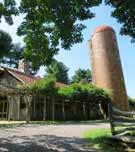
2003: The Barn at Fallingwater receives Silver LEED certification and several awards. Wastewater treatment facility installs.
Architects Bohlin Cywinski Jackson complete renovations of the former dairy barn purchased by the Kaufmanns in the 1940s, converting areas into offices and meeting and event space. Called The Barn at Fallingwater, it receives a Silver LEED certification and wins a number of AIA local and national awards, including one of the Top Ten Green Projects, American Institute of Architects, Committee on the Environment. Also as a model of sustainability, a state-of-theart, closed-loop, zero-discharge waste water treatment facility is installed. The system, designed and installed by CH2M Hill, treats waste water that is then recycled for other uses on the property such as non-potable water and drip irrigation.
“I liked that I got to design something original like Wright did and actually build a model by hand.”
–Trent Hicinbothem, 2019 Gnome House Design Challenge participant

alternative watering sources and streamside
reduce streambank erosion and filter pollutants.

We establish Erie Bluffs State Park.
In 2004, we transfer 540 pristine acres along the Lake Erie shoreline to Pennsylvania Department of Conservation and Natural Resources to establish Erie Bluffs State Park. In mid-July, Bioblitz is held in the park. Eighty species of birds, 19 species of mammals, 302 species of plants and 94 species of fungi are found. Bald eagles cruise along the bluffs, and migratory birds rest and refuel along the coast before migrating across the lake. Great Lake Bluff Seeps, a natural community type that is critically imperiled in Pennsylvania, supports a number of rare plant species, including variegated horsetail, Virginia blue flag, small-headed rush and northern green rush. With conservation partners of the Lake Erie Watershed Cooperative Weed Management Area, we have led efforts to control invasive species.
2006: Painter Felix de la Concha becomes the second artist-inresidence at Fallingwater. The 18-month residency resulted in nearly 50 paintings, which capture Fallingwater at various times of day and in all seasons. From the collection an exhibition titled “Fallingwater en Perspectiva” is organized and tours four venues in the United States.
2006: Our role in the Pennsylvania Natural Heritage Partnership expands to include Eastern Pennsylvania.

2007: We complete bathymetry mapping work of the Allegheny River.
Our water quality experts take on an important 75-mile stretch of the Allegheny River in the name of water quality! They complete a depthmapping project, using a method called bathymetry, to better understand and evaluate underwater conditions for fish and mussel habitat. The project generates new and much-needed data and topographic mapping, using ArcGIS and 3D applications, for one of the most densely populated sections of the Allegheny River for freshwater mussels from Parker, Pa., to the turnpike bridge in Harmarville, Pa. This GIS-ready data is available to build a comprehensive system to manage the river and prioritize further mussel survey locations and other research. It is the first time bathymetric mapping is used for the Allegheny.

“I appreciate the Conservancy’s long history of preservation in Western Pennsylvania, from enabling some of our most beautiful state parks to be created to ongoing watershed conservation. And of course, Fallingwater is an absolute treasure!”
– Marie Cosgrove-Davies, chair of WPC’s Emerging Leaders
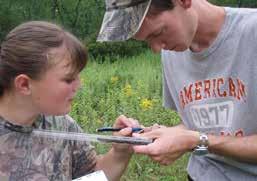
2007: We complete first telemetry study of eastern massasauga rattlesnakes.
It takes a special person with extensive expertise to attach radio transmitters to rattlesnakes. During the past century, populations of the eastern massasauga rattlesnake decline from 19 in six counties to four in Butler and Venango counties. To study the movement and habitat of these small endangered snakes, which are a vital part of our ecosystem, our PNHP staff begin a radio telemetry project in 2007, equipping 51 free-ranging massasaugas with temperature-sensitive radio transmitters. After five years of intensive research, PNHP develops and implements the Massasauga Habitat Protection Plan. As of 2022, the Conservancy has purchased three massasauga properties totaling 60 acres, and staff provide expertise to restore 80 acres of massasauga habitat on Conservancy and private property by removing woody vegetation.
Read more and watch a video about our ongoing massasauga work.
“It’s great to work with other people who are passionate about their community, and you build a strong bond with them through the hands-on work of volunteer events.”
– Eric Chiu, volunteer

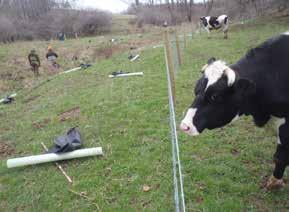
In 2006, the Conservancy is awarded $1 million to help landowners in the Ohio River Basin apply for funding through the federal Conservation Reserve Enhancement Program, a land retirement program that provides financial incentives for farmers to take already marginal land out of production and support conservation objectives. It is our first substantial involvement in planting trees in riparian areas, the sensitive area between land and water. Riparian plantings help prevent streambank erosion and filter pollutants such as agricultural runoff.

2008: TreeVitalize Pittsburgh partnership begins.
Imagine every street in every neighborhood, lined with green, shade-giving trees that soak up rainwater, provide life-giving oxygen, absorb excess carbon dioxide and provide food and habitat for birds and small wildlife.
In 2008, the TreeVitalize Pittsburgh partnership begins, with the goal of planting thousands of trees in the Pittsburgh region. Since then, TreeVitalize Pittsburgh has planted nearly 39,000 trees in 73 Pittsburgh neighborhoods
and 57 municipalities in Allegheny County. A partnership of PA Department of Conservation and Natural Resources, City of Pittsburgh, Tree Pittsburgh and WPC, TreeVitalize Pittsburgh is supported by grants by various foundations and companies.
2008: Access to waterways for canoeing and kayaking improves, thanks to our members Roy Weil and Mary Shaw, who establish the Canoe Access Development Fund.
2008: We protect more than 11,000 acres, as part of our 75th Anniversary Acquisitions. The purchases, which are WPC’s largest in a decade, include portions of forests in Clarion, Somerset, Elk and Clearfield counties. The acquisitions were made possible by a grant of nearly $8 million from the Richard King Mellon Foundation and $4.5 million from the Pennsylvania Department of Conservation and Natural Resources.

"Since beginning my amazing career at the Conservancy in 1973, I have been exceedingly proud to have been involved in an evolving organization that remained laser focused on its mission while being consistently positioned to seize opportunities to achieve greater levels of conservation.
For nearly 50 years, it has been rewarding to take part in the Conservancy’s acquisition of hundreds of thousands of acres of wild lands and natural areas for habitat protection that will also afford recreational opportunities to everyone, for all time. It has also been an honor to help guide the Conservancy’s role in making communities more attractive and livable through a multitude of greening measures and bringing together diverse volunteers to help make their neighborhoods stronger and more inviting."
– Cynthia Carrow, WPC vice president of government and community relations and WPC member
Cynthia is the longest-tenured employee with 49 years of service.

at 57 Pittsburgh
Public high school and elementary schools enjoy outdoor spaces for learning, natural play, food gardens and more. In 2009, thanks to a $1.5 million grant from the Grable Foundation, the Conservancy’s School Grounds Greening project begins. Students help Conservancy staff plant 700 large trees and 9,000 shrubs and perennials. Children enjoy 18 outdoor classrooms, six natural play spaces, five quiet reading and sitting areas, raised planting beds, three food garden beds, a rain garden, plants that provide shade and natural points of interest, a sensory garden and a butterfly garden. In 2022, School Grounds Greening continues with a focus on Early Childhood Centers that serve preschool children in the City of Pittsburgh.
2012: We become an accredited land trust with the Land Trust Accreditation Commission, an independent program of the Land Trust Alliance.
2011: Our watershed program marks its 10-year anniversary. In addition to the team’s work restoring rivers and streams, by this date, 100 miles of streambank fencing are installed and technical assistance to 550 different entities provided.
Fallingwater celebrates its 75th anniversary! Staff and visitors commemorate the occasion through a variety of experiences, including the publication of "Fallingwater," edited by thenDirector Lynda Waggoner, an international symposium on presenting the modern house museum titled “Private Domains/ Public Displays: The Modern House Interpreted,” a gala celebration that includes a light and sound show projected on the building by Luftwerk, and a concluding exhibition at Concept Gallery of the paintings of Felix de la Concha.

Appalachian Trail Natural Communities for NatureServe.
Known for its steep, rocky terrain in Pennsylvania, the entire 2,000-mile Appalachian Trial stretches nearly unbroken from Georgia to Maine through protected lands. To help wildlife on these lands thrive, we partner with NatureServe to identify and map the rare, threatened and endangered plant species located along the Pennsylvania portion of the Appalachian Trail. This inventory helps inform future management plans to help native plant communities thrive and control invasive species.
2014: Our watershed program completes its first hellbender eDNA project with the Smithsonian and the National Zoo.
eastern hellbenders and other aquatic life.
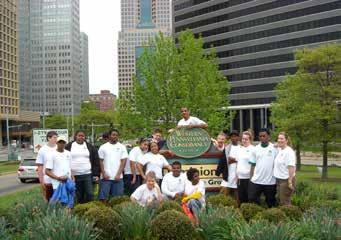
2009: A record-setting 10,000 volunteers contribute 50,000 hours to our community gardens and greenspace program.

PA.
From Asiatic sand sedge to zebra mussels, invasive species threaten Pennsylvania’s plants and animals, and harm the environment, the economy and human health. In 2010, the Pennsylvania iMapInvasives program is launched to spearhead a movement to share invasive species data with local, state and government entities in the state. The Pennsylvania iMapInvasives program is administered by PNHP staff, who provide educational materials about invasive species and iMapInvasives apps, review invasive species reports submitted to the database, assist with invasive species field surveys and the creation of invasive species management plans and more. A community of database users includes people from agencies, academia and nonprofits as well as consultants and community scientists. Natural resource professionals use the data to track and manage invasive species.
2013: We install two bioswales in Millvale as our first green infrastructure projects.
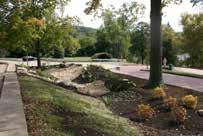
Located in a valley surrounded by hills and residential and commercial development, the Borough of Millvale, Pa., has a long history of flooding. The borough is located within the
Girtys Run watershed, which is affected by stormwater runoff that includes sediment such as litter, auto fluids and pet waste.
In 2013, the Conservancy completes two bioswales at Sisters of St. Francis Mount Alvernia as part of the Millvale TreeVitalize project to help reduce stormwater runoff. Funded by a grant from PennVest in 2012 and at the time the largest green infrastructure project in Allegheny County, one bioswale is approximately 400 feet long and intercepts 89% of rainfall from an 11-acre tributary area. Another captures water from a 1.2-acre area.
Read about bioswales and other natural stormwater management projects.
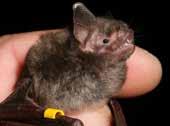
PA Conservation Explorer Tool goes public.
A one-stop shop for conservation planning and Pennsylvania Natural Diversity Inventory environmental review, the Pennsylvania Conservation Explorer debuts. It provides conservation information on the state’s biological diversity, protected lands, streams and other natural resources for planning purposes. It also allows users to screen a project area for potential impacts to threatened, endangered and rare species for construction and development projects. Contractors, biologists, teachers and community scientists can create an account to review data and information on the state’s biodiversity. At least a dozen other states follow Pennsylvania’s lead to create a similar tool, but our tool is considered to be one of the most sophisticated versions of natural diversity inventories in the country.
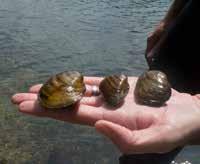
In 2015-16, we partner with other agencies and experts for a special project in the Allegheny River near West Hickory, Pa., to relocate freshwater mussel species. Working with several partnering agencies, our watershed conservation and natural heritage staffs move thousands of federally listed, threatened and endangered freshwater mussel species, as well as common mussels, from the direct impact zone of the Hunter Station Bridge replacement on the Allegheny River near President, Pa. We relocate 402 individual mussels of eight common species into 10 sites in the Clarion River. Together, the partners relocate 36,419 federally endangered and 7,915 common species.
2015: Our largest land acquisition of more than 17,000 acres brings our land protection to more than a quarter of a million acres.
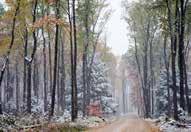
Our total land protection exceeds a quarter of a million acres of forests, wetlands and waterways in 2015 when we make our largest land acquisition to date, more than 17,000 acres in McKean County. It is also the largest land addition to the state forest system in 65 years, significantly increasing the amount of state forestland available for hunting, fishing, hiking and other recreational activities. As of 2022, we've protected more than 264,000 acres across the region.
2015: Continuing our green infrastructure and stormwater management work, we install a bioswale and rain garden in Point State Park in Pittsburgh.
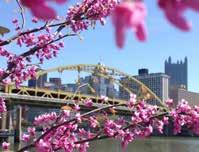
Pittsburgh might be known as the City of Black and Gold, but when springtime arrives, everyone is seeing pink! In 2016, we launch The Pittsburgh Redbud Project with the goal of planting 1,200 native Eastern redbuds and complementary trees in view of Pittsburgh’s rivers by spring 2017. Each spring, our riverfronts and parks come alive with pink, purple and white blossoms that provide food for pollinators and wildlife habitat. With volunteers and partners, we've planted and continue to care for thousands of trees and shrubs as part of this beautification and restoration project along the Three Rivers Heritage Trail, on the North Shore Riverfront Trail and in downtown Pittsburgh.

2017: To connect local farmers with local land to grow produce and raise livestock, we launch our Farmland Access Initiative. Our new initiative leases farmland for small-scale agricultural operations.
2016: We dedicate and open the Dr. Colson E. Blakeslee Memorial Recreation Area, a 24-acre natural area in Elk County, to the public. The site honors Blakeslee, a local doctor and emeritus WPC board member, fondly known as “Doc,” who died in 2011 and was a tireless advocate for conservation efforts in the region.

Fallingwater Institute is established.
An ideal setting for big ideas, innovative thinking and creative discussion, Fallingwater launches Fallingwater Institute, which expands and enhances our education programming to offer a robust schedule of residencies, workshops, camps and convenings. When Edgar Kaufmann jr. donated Fallingwater to us in 1963, he did so with the understanding that it would be forever preserved not only as a place for the public to experience architecture, art and nature, but also as a hub for intellectual discourse for forward-thinking and creative individuals. By serving an international community through its innovative programming, Fallingwater Institute works to create and disseminate new ideas that promote harmony between people and nature.
2015: Our Shared Legacy campaign concludes with so many great outcomes! More than 24,000 people, foundations and corporations pledge 65,000 gifts that total $59 million in private funding to support our region’s water, land and wildlife, and the preservation of Fallingwater.
2016: A new population of upland chorus frog is found during a natural heritage inventory update in Bedford County. The frog is an endangered species, with fewer than five populations known through the state.

2016: High Meadow, designed by Bohlin Cywinski Jackson, opens to rave reviews and receives AIA Pennsylvania Silver Medal. It serves as the lodging and studio facility for Fallingwater Institute participants.
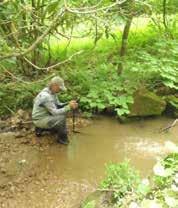
2017: We use NAACC standards for aquatic connectivity.
Removing dams and undersized culverts helps fish and water quality. To advance our work to reconnect streams with naturally reproducing brook trout and other aquatic life, we begin using the new North Atlantic Aquatic Connectivity Collaborative protocol. NAACC is a network of individuals from universities, conservation organizations, and state and federal natural resource and transportation departments focused on improving aquatic connectivity across a 13-state region, from Maine to West Virginia. Its protocol is a best-practice model for which all of our aquatic organism passage projects are evaluated. This methodology is now in use for all of our AOP projects and allows structures to be ranked and assessed for the greatest potential for upstream habitat reconnection.
2018: We complete a 535-foot bioswale in Pittsburgh’s Hill District neighborhood that intercepts 882,000 gallons of stormwater. It includes 13,000 perennials, 87 shrubs and 25 trees.
2018: We protect 1,948 acres, bringing the total WPC-conserved land in Western Pennsylvania to more than 257,000 acres.

Thanks to TreeVitalize Pittsburgh partnership volunteers, thousands of trees are being
our
our
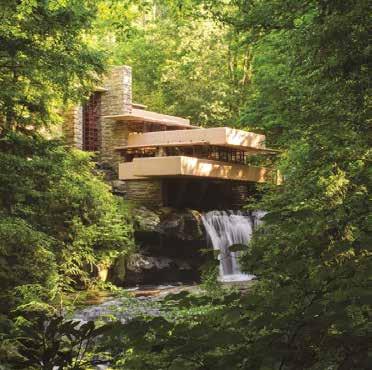
2019: Fallingwater and seven other Frank Lloyd Wright-designed sites are inscribed to the UNESCO World Heritage List.
On July 10, 2019, Fallingwater and seven other Frank Lloyd Wright-designed sites are inscribed to the UNESCO World Heritage List. The inscription, “The 20th-Century Architecture of Frank Lloyd Wright,” represents the first modern architecture designations in the United States. These eight sites have played a prominent role in the development and evolution of modern architecture during the first half of the 20th century and continuing to the present.
Watch a short video about Fallingwater’s World Heritage Inscription.
Read about Fallingwater’s inscription to the UNESCO World Heritage List.

2018: We install and plant Pittsburgh’s first ADA-accessible raised garden beds.
Planting and tending to colorful flowers becomes more accessible for everyone in Pittsburgh when we plant our first ADAaccessible community flower garden in 2018. We build raised, wheelchair-accessible flower beds, connected by crushed limestone pathways, at our existing garden at the First United Methodist Church of Pittsburgh, with funding from the Allegheny Regional Asset District (RAD). The flower beds expand gardening opportunities for people with disabilities or other physical limitations. As part of their outdoor classroom and nature curriculum, students from The Children’s Institute of Pittsburgh regularly visit the garden to help with care, planting and weeding. Volunteers with disabilities or physical limitations can borrow our specialty gardening tools such as long-reach hoes, trowels and forks, made possible thanks to RAD funding. Let us know if these tools are needed when signing up to volunteer at any of our 130 community flower gardens.
2020: Fallingwater partners with 412 Food Rescue to distribute free “Farmers to Family” food boxes to families struggling with food insecurity.
2020: We join other local organizations to express solidarity with peaceful protests advocating for racial unity and social equality. While diversity and inclusion are well-established core values at WPC for more than a decade, our staff and board work to advance community engagement, diversity, inclusion, equity and environmental justice as essential components of our 2022-2024 strategic plan.

2020: Watershed conservation staff discover eight species of freshwater mussels in the Kiski River in Armstrong County, including some that haven’t been seen there in more than a century.

2020: Toms Run Nature Reserve trail and improvements are complete.
Staff and volunteers work at Toms Run Nature Reserve in Allegheny County for more than 10 years to remove trash and derelict buildings, plug abandoned gas wells, create trails and expand the parking area to make the reserve a more welcoming place to explore nature. In 1977, we began protecting land to create the preserve. Over time more land was protected and added, and by 1991 it had stretched to 317 acres. In 2020, with the help of dedicated volunteers, we finish the improvements and blaze the 3.5-mile scenic loop trail. Now at 369 acres, the preserve includes a parking area and benches at scenic overlooks. Visitors can watch wildlife and see giant Allegheny ant mounds and an old stone foundation where a house once stood.
an existing WPC community garden site in Pittsburgh’s Homewood neighborhood.

2018: The 0.6-mile
Memorial Recreation Area Trail is completed as part of the 700-acre Casselman River Conservation Area.
2019: Staff work on a national project to combine 40 years of natural heritage information, providing expertise to help create the Map of Biodiversity Importance (MoBI).
2019: In a multi-year study that concludes in 2019, our PNHP and watershed conservation program scientists seek mussel species, including the endangered salamander mussel, in the Ohio River. They find 13 freshwater mussel species.
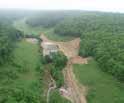
2020: Bennett Branch Forest’s AMD pond system activates.
At 1,465 acres, our Bennett Branch Forest in Clearfield and Elk counties is an outdoor lover’s paradise. The mixed hardwood forest, stands of hemlock and mountain streams descend along steep slopes from a broad plateau.
2018: We complete ecological assessments for Hartwood Acres and Settlers Cabin county parks.
2019: The Clarion River is named 2019 Pennsylvania River of the Year. Since the 1970s, we have done extensive land protection and watershed restoration work to benefit the river.
2019: Our watershed program exceeds 55,500 riparian trees planted.
2019: Pennsylvania names the Eastern hellbender, a species of concern, as the state amphibian. We have monitored hellbender populations since 2007.
2019: We celebrate 10 years of providing Canoe Access Development Funding for partners to create or improve canoe access sites on local streams and rivers. As of 2022, we have funded 89 sites.
As a result of years of mining, Cherry Run — a tributary to the Bennett Branch that flows through Bennett Branch Forest — had multiple abandoned mine drainage (AMD) seeps polluted with dissolved aluminum. This drainage kills fish and other aquatic life. To clean the stream, Beran Environmental develops a remediation and restoration plan for a passive treatment system, which consists of a series of retention ponds lined with clay and limestone. As the discharge water flows through the ponds, the limestone raises the pH level and solidifies the aluminum, which then falls out of the water and is retained in the settling pond. Each pond removes more aluminum before the treated water flows back into Cherry Run. The AMD pond system will remain in place forever, helping life return to the stream.
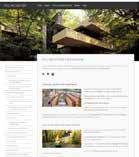
2020: Architectural enthusiasts still experience Fallingwater from home through virtual and new offerings.
The global pandemic keeps Fallingwater’s doors closed for most of the 2020 tour season. But it also helps us think more creatively about how people can continue to enjoy learning about the house, nature and architecture. During 2020, we expand educational programming with virtual offerings for online audiences, including virtual field trips for school students and free monthly webinars for everyone. We also begin offering weekly interactive livestream tours called “A Closer Look,” which are exclusive, behind-the-scenes views and discussions about unique aspects of the house’s interior and life at Fallingwater. We expand our exterior tour program and offer Winter Walks. And 719 students participate in Fallingwater’s Gnome House Design Challenge, learning about art, math, science and more, while building houses for gnomes.
2020: PNHP completes Climate Change Vulnerability Index, which provides assessments for 85 species in Pennsylvania.

“I love it when young learners from around the world build houses for me and my buddies. We get to experience new digs while they learn important art and design skills. And we get to hang out at Fallingwater each May! How cool is that?"
– Dimflonk Gnome Berrybang, proud owner of a new home at Fallingwater
2020: We expand a community flower garden site in Pittsburgh’s Larimer neighborhood into a pollinator-friendly rain garden, planting nine trees and 262 native plants.
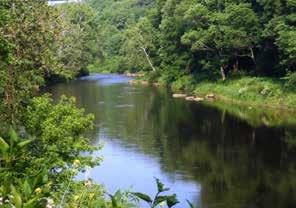
2021: We transfer 532 acres along the Clarion River to the U.S. Forest Service for the Allegheny National Forest.
Visitors to the Pennsylvania Wilds can enjoy more protected land in state forests when we protect two forested properties totaling 152 acres in 2021. The lands are immediately conveyed to the PA Department of Conservation and Natural Resources Bureau of Forestry, expanding public state forestland, protecting water quality, providing flood mitigation for downstream communities and expanding hiking and fishing opportunities. We add an 89-acre property in Summit Township, Potter County to Susquehannock State Forest. With more than 3,000 feet of stream frontage and mature hemlock and hardwood forests, it includes the confluence of two streams that form First Fork Sinnemahoning Creek, listed by the PA Fish and Boat Commission as one of Pennsylvania’s best trout fishing streams. Elk State Forest Cameron County grows by 63 acres when we add a forest that is known for stocked trout and bass fishing and habitat for elk and other wildlife.

2021: In partnership with the U.S. Forest Service, we place silos housing juvenile mussels at strategic spots in 13 streams to test the survival rate of the mussels.
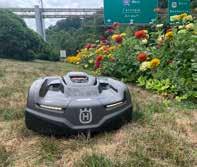
2020: Community Gardens and Greenspace staff begin using ecologically friendly tools, including a Husqvarna selfpropelled, electricpowered mower.
2021: WPC’s PNHP staff completes "Priorities for Climate Change Connectivity in PA," a study that prioritizes where connected landscapes would be beneficial for species migration in the face of climate change.
2021: Fallingwater reopens for interior tours in May 2021 after only offering exterior tours during much of the 2020 season. Virtual school field trips are launched as the pandemic continues.
2021: Fallingwater Café receives Gold designation by Sustainable Pittsburgh Restaurants.
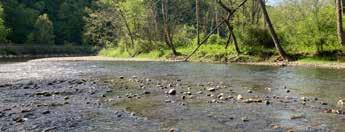

2021: Conservancy staff and volunteers plant more than 1,000 pollinator-friendly perennial flowers, three trees, 24 shrubs and 55 grasses in the First Avenue and Grant Street garden in downtown Pittsburgh, creating safe nesting habitat for pollinators.
2021: The Pittsburgh Redbud Project celebrates five years of “pinking” Pittsburgh. Since 2016, staff, volunteers and partners have planted nearly 3,800 trees for the project — of which approximately 1,600 are native Eastern redbud.

2021: To possibly control the spread of invasive and destructive hemlock wooly adelgid at Bear Run Nature Reserve, we release a natural predator, the Ln beetle, within an insectary.
2021: Our PNHP staff leads an intensive marsh bird survey in Pennsylvania’s largest contiguous wetlands — Conneaut Marsh, Pymatuning Reservoir and Hartstown Marsh — in Crawford County. Data includes 27,438 bird detections of 148 species, including 27 species of conservation concern in the state.
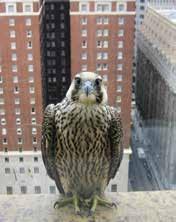
2021: The $1.2 trillion bipartisan infrastructure bill is great news for funding water quality improvements, such as our AMD work.
2021: The Pennsylvania Game Commission delists the peregrine falcon from its threatened species list. In 1989 Conservancy staff observed a pair of falcons hunting around Pittsburgh’s skyscrapers. Before that, it had been 33 years since peregrine falcons had been known to nest in the region. The Conservancy managed nesting boxes from 1990 to 2006, including at the Gulf Tower, where 63 young hatched between 1991 and 2010.

2022: During the nine decades since the Conservancy began, our programs and conservation efforts have really grown! We have protected more than 264,000 acres of natural lands in Pennsylvania, helped to establish 11 state parks, protected or restored more than 3,000 miles of rivers and streams, and planted 105,000 trees. We also plant and maintain 130 community flower gardens in 20 counties, provide 41 nature preserves for all to enjoy and steward Fallingwater, a UNESCO World Heritage Site.

On
announce the installation of a solar array at Fallingwater.
2022: Another conservation easement protects more land in Ligonier Valley, Westmoreland County. To date, we permanently protect nearly 27,000 acres of forests and streams in the Ligonier Valley, of which more than 10,000 are through conservation easements.
2022: WPC awards a contract to provide cultural and historical research, reporting, interpretive education and training services for the “Untold Stories of Pennsylvania’s State Parks & Forests.”
What will the next 90 years bring? Great things have been accomplished, but there’s still much work to be done. We need to plant more trees in cities and towns, protect more land for wildlife, nature and people to thrive, restore more rivers and streams, study more wildlife and preserve Fallingwater to stay resilient and relevant. So, the next 90 years — and the next generation of nature lovers, preservationists and conservationists — need all of us. Here’s more from some of our members and volunteers about the importance of nature and making a difference locally for conservation. Let’s continue to be nature's heroes!
“The WPC holds a special place in my heart; not only the attentive staff that works tirelessly to keep this wonderful nonprofit afloat, but the work that they do. The protection and restoration of our natural areas ensures a brighter and more beautiful future for my generation, and those to come! Becoming a member has been an honor, and the volunteer opportunities fill my heart with joy, as I am able to demonstrate my support in a tangible manner.”
– Jessica Suss, WPC member


2022: Bentley Run Wetlands in Erie County opens to the public for hiking, wildlife watching, hunting and fishing, and is adjacent to State Game Land #102. Protecting land and water within the French Creek watershed continues to be of great importance to the Conservancy, with more than 6,000 acres conserved to date.

“I love the instant gratification of planting a big a tree in our neighborhood, and the pride I feel every time I see that tree.”
– Julie Ewing, volunteer
“We need more local groups and connections with whom we can develop relationships for volunteering. And we encourage people who use our 41 preserves to support our initiative so that these preserves will be protected and available for future generations.”
– Andy Zadnik, WPC director of land stewardship
“I want to leave this world better for him and a legacy of caring for nature that he can be proud of.”
– Charles W. Bier, WPC member and senior director of conservation science, says about his grandson, Roland

“This is a majestic architectural gem right here in our backyards – if we don’t feel compelled to protect and preserve it, who will? We have to share the gift of Fallingwater with others so it can be around for another 80 plus years. It’s meaningful that I can still use my teaching background in a way that inspires others after all these years, and that’s a pretty satisfying feeling.”
– Dan Bonga, Fallingwater member and volunteer
“Every little thing we do improves water quality and supports precious wildlife. To know I have that power is inspiring.”
– Vancie Peacock, student who has benefited from our education programs


“The stream stabilization was just another thing we could do to improve the farm. Our grandkids and others that follow us, whether family or not, will benefit.”
– Jack Krider, local farmer
has worked closely with

“We feel that it’s our responsibility to enjoy and care for nature right in our own backyards. It’s such a good feeling when we are planting and people in the community wave, beep their horns and say thanks. We are planting, caring and beautifying this land for them as much as we’re doing it for ourselves, and nature as a whole.”
– Helen Bowers, vice president of the Pittsburgh alumnae chapter of Delta Sigma Theta Sorority, Inc. Delta Sigma Theta Sorority has planted and cared for the WPC community flower garden in Pittsburgh’s Homewood community since 2015.
800 Waterfront Drive
Pittsburgh, PA 15222
412-288-2777
info@paconserve.org
WaterLandLife.org

Join us in celebrating 90 years of impact in our region by making a special gift this holiday season.
Together, we have protected more than 264,000 acres of natural lands, restored more than 3,000 miles of rivers and streams and planted more than 105,000 trees. We also plant and maintain more than 130 community gardens and greenspaces each year in cities and towns across our region, provide 41 nature preserves for all to enjoy, and care for Fallingwater, a UNESCO World Heritage Site.
Your support empowers everything we do. As you think about your year-end charitable giving this holiday season, please consider making a special gift to help protect Western Pennsylvania’s most beautiful and inspiring places — now and for generations to come.
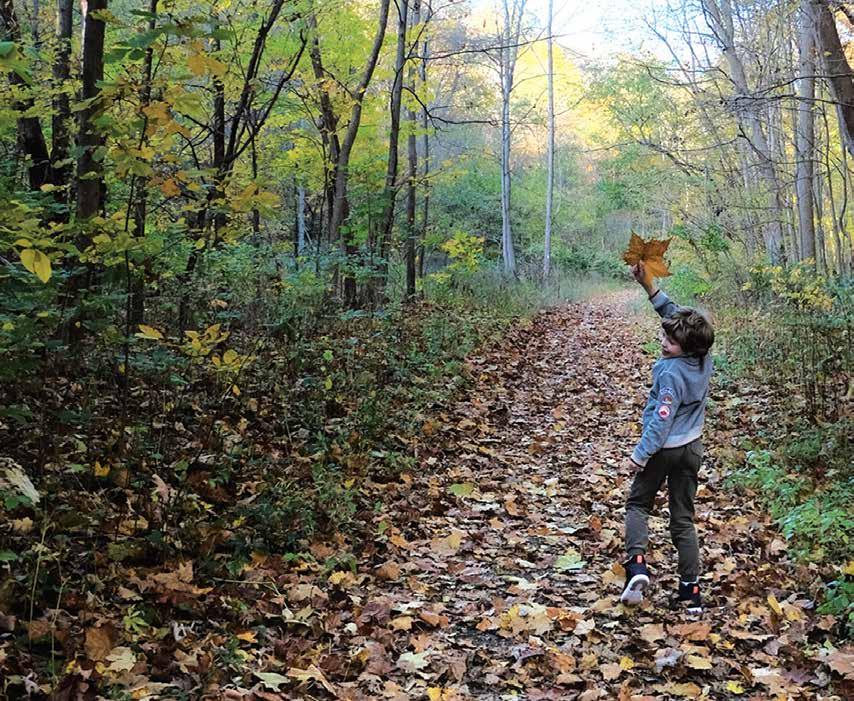

You can use the enclosed envelope, scan the code below with your phone or simply visit WaterLandLife.org/Donate to make your gift today.
Thank you for being nature’s hero!